There are three invasive grasses and six invasive vines that Michigan residents should be aware of.
Pale Swallow-wort and Black Swallow-wort, also known as dog-strangling vine, have both been detected in Michigan. These perennial vines can grow up to seven feet in length and the roots are toxic to mammals. The plants are toxic to many insect larvae, including monarch caterpillars.
The Kudzo is another interesting vine that has been detected in Michigan. The roots can grow six feet long and can weigh up to 400 pounds. The vines can extend 32 to 100 feet and tends to smother and shade out native plants.
Asiatic Sand Sedge
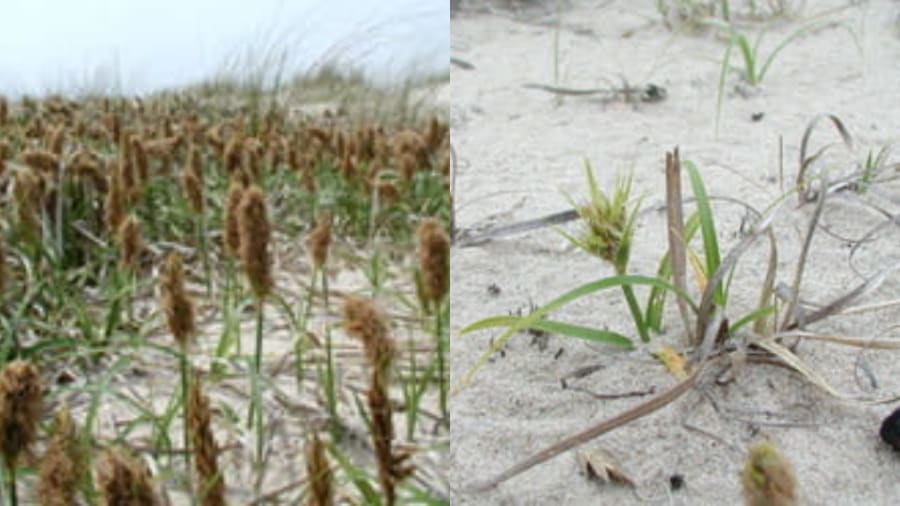
- Name: Carex kobomugi
- Status: Not detected in Michigan
- Learn more: Michigan.gov
This perennial sedge grows to about a foot tall. It has a triangular stem with brown scales at the base. The leaves are often taller than club-shaped flowering heads. There are small ridges along the edge of the leaves, making it feel serrated.
They can grow in the upper parts of coastal beaches and dunes. It is tolerant to salt spray, high winds, and drought. They are native to the coastal areas of China, Japan, Korea, and Russia. They are found along the East Coast of the United States from Massachusetts to North Carolina.
Michigan officials are concerned because these grasses can out-compete native dune grasses and may cause dunes to be vulnerable to erosion and wind blowouts.
Japanese Stiltgrass
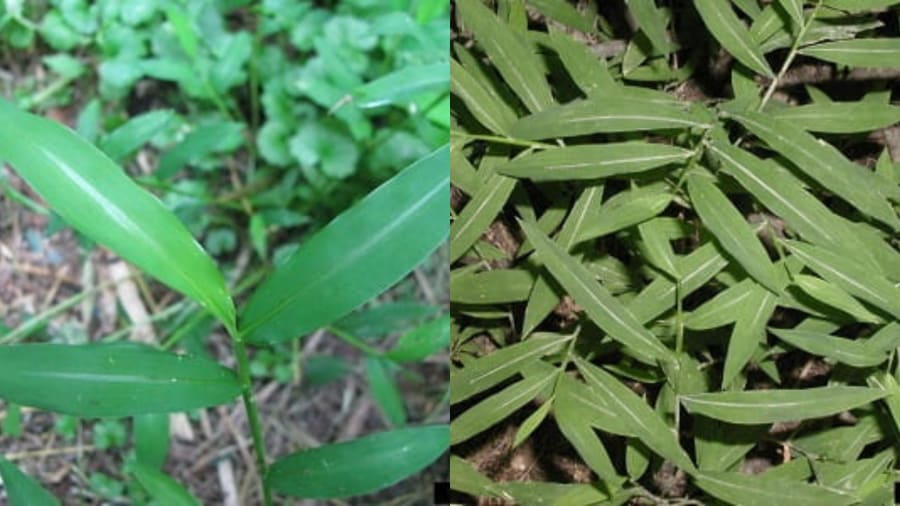
- Name: Microstegium vimineum
- Status: Detected in Michigan
- Learn more: Michigan.gov
This is a delicate, low-growing annual grass. The stems sprawl over one another at root and nodes. It has short leaves that are pale green, lance-shaped, and have a distinctive, shiny mid-rib that is slightly off-center. It is native to China, Japan, Korea, Malaysia, and India.
It is an annual grass that is very adaptable and tolerates varying levels of soil acidity and moisture, but it does prefer forested floodplains. It will grow in deep shade or full sun. It was first documented in Tennessee in 1919 and it had been introduced as a packing material for goods from Asia. It has spread across the eastern U.S. as far north as New Hamshire and as far south as Texas.
Michigan officials are concerned because stiltgrass produces 100-1,000 seeds per plant and can spread rapidly by water flow, wildlife, and foot and vehicular traffic. Deer will browse native plants and avoid stiltgrass, which means it can continue to spread.
Phragmites (Common Reed)
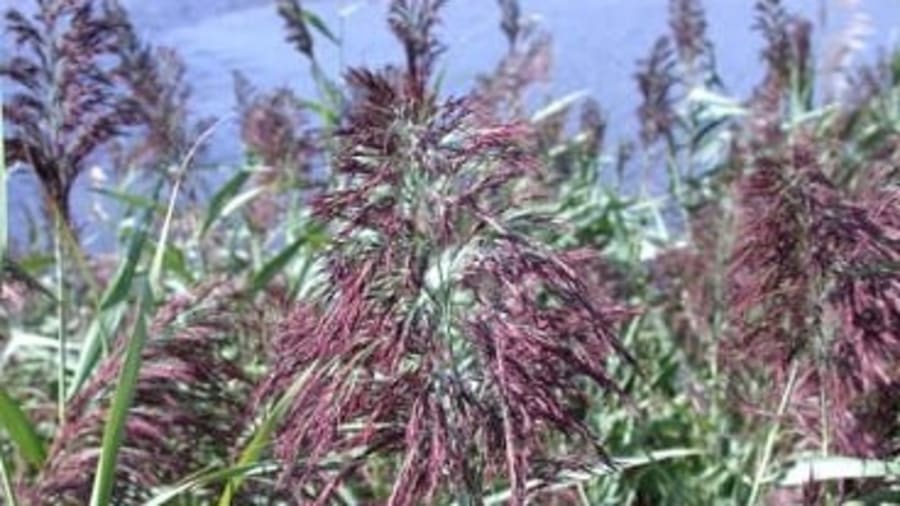
- Name: Phragmites australis
- Status: Established in Michigan
- Learn more: Michigan.gov
This is a warm-season perennial grass with a rigid, hollow stem. It usually grows between six to 13 feet tall. Its leaves are flat, smooth, and green to grayish-green. Its flowers grow as dense branched clusters on the end of each stem that are open and feathery at maturity. It is often found in ditches, swales, wetlands, and on stream and pond banks.
It is native to North America and found all over the world. One strain of the species is believed to be exotic or hybrid and is quickly replacing the native strain. They can be difficult for human and wildlife to walk through and often obstructs views because it grows so tall and dense. The exotic strain can reduce native fish and wildlife populations, block out native salt marsh vegetation, and can pose a fire danger.
Black Swallow-wort (Dog-strangling Vine)
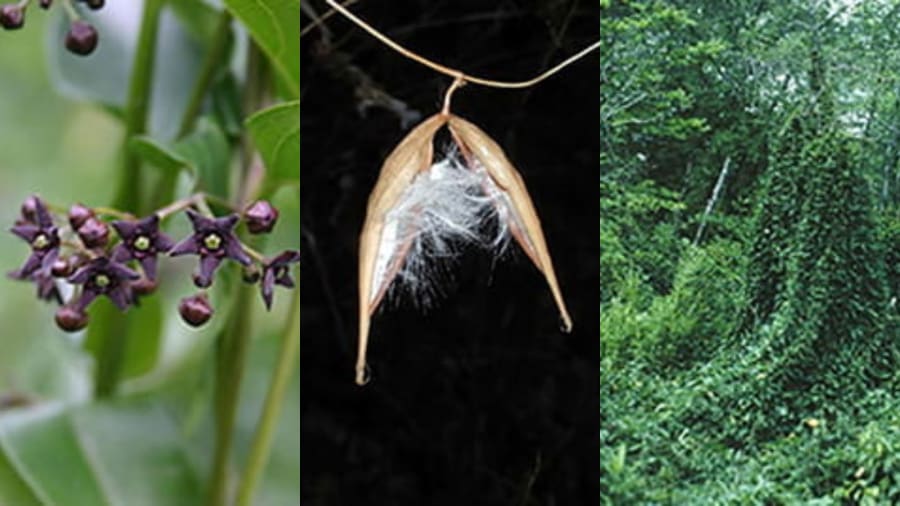
- Name: Cynanchum louiseae (Vincetoxicum nigrum)
- Status: Detected in Michigan
- Learn more: Michigan.gov
This perennial vine grows up to seven feet in length. Its leaves are shiny, dark-green, and oval to heart-shaped with a pointed tip. It has small, star-shaped flowers that are dark purple and have five petals and grow in clusters of six to 10 blooms.
It thrives in both shaded and sunny areas and is often found in disturbed areas along roadsides, pastures, old fields, and gardens. It is a concern in Michigan because it grows rapidly and can cover other vegetation. The seeds are carried on the wind or transported by water. Its roots are toxic to mammals, including livestock. The plants are toxic to many insect larvae, including monarch caterpillars.
Chinese Yam
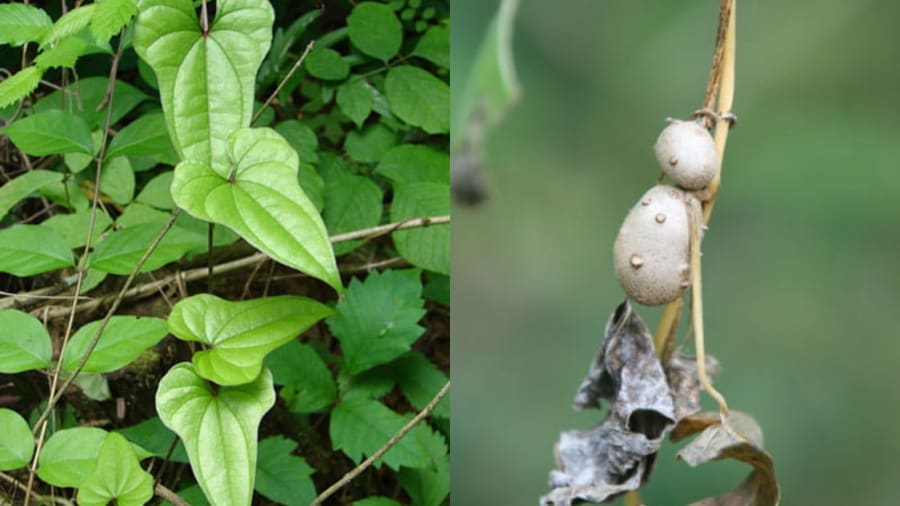
- Name: Dioscorea oppositifolia
- Status: Detected in Michigan
- Learn more: Michigan.gov
This vine has pointed, heart-shaped leaves that are often indented on the sides. The slender vines spiral counter-clockwise. Bulbils or air tubers are present from June to September and resemble very small potatoes. It has small white or greenish-yellow spikes of flowers that smell similar to cinnamon.
It can be found along roadsides, fence rows, stream banks, ditches, and rich, mesic forests. It tolerates anything from full sun to deep shade, but it prefers intermediate light. They are a concern in Michigan because they can grow up to 16 feet in height and engulf surrounding vegetation. The vine dies back in the winter, but it grows and reproduces quickly enough to reduce plant diversity in the area.
Kudzu
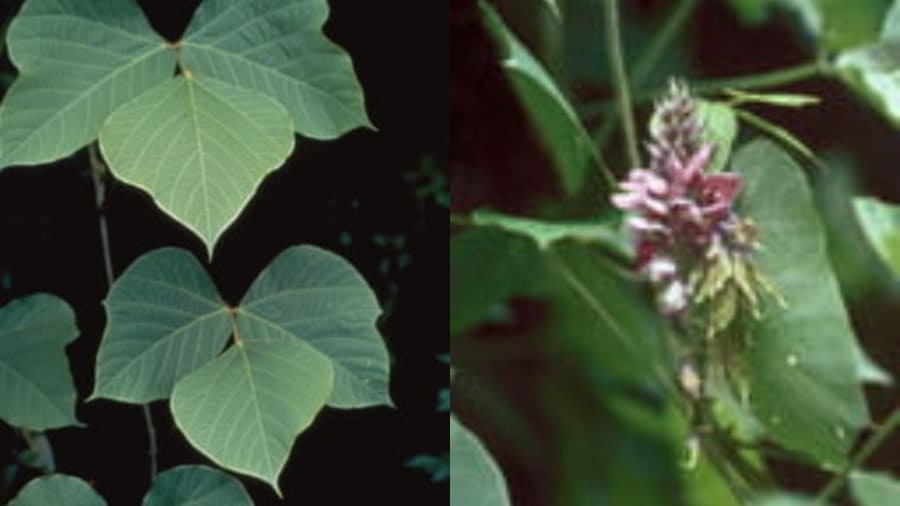
- Name: Pueraria montana var. lobate
- Status: Detected in Michigan
- Learn more: Michigan.gov
These vines extend 32-100 feet and have up to 30 vines/plant. The root grow up to 6 feet and can weigh up to 400 pounds. It has alternate, compound leaves with three broad leaflets. Purple individual flowers grow in upright clusters in late summer.
This climbing perennial vine can grow well under a wide variety of conditions and in various soil types. It prefers sunny and open areas. It’s a concern in Michigan because once it’s established it tends to smother and shade out native plants.
Mile-A-Minute Weed
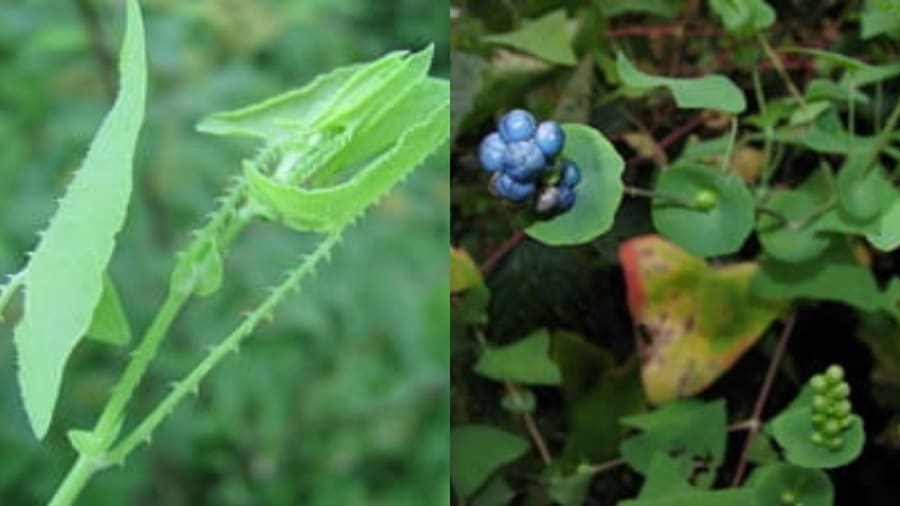
- Name: Persicaria perfoliata, Asiatic tearthumb
- Status: Detected in Michigan (Calhoun County)
- Report: If you see this weed, you should take photos and note the location, date, and time you saw it. Send that information to the Midwest Invasive Species Information Network using its online reporting tool.
- Learn more: Michigan.gov
This annual trailing vine lives in open and disturbed areas with a preference for wet soil. It’s fast-growing and has leaves shaped like equilateral triangles. The stems are narrow, delicate, green, or red. There are recurved barbs on the stems and the undersides of the leaf blades. There are spikes of pea-sized blue fruit that appear in July.
It is often found along stream banks, open spaces, roadsides, forest edges, and fence lines. It thrives with a lot of sunlight and uses its recurved barbs to attach and to climb over other plants. It has been identified in Calhoun County.
This vine can grow up to 25 feet in six to eight weeks and it overtakes native vegetation. Christmas tree farms, orchards, reforestation, and restoration areas are at risk because this vine will smother tree and plant seedlings.
Seeds from this vine can live in the soil for up to six years. Each fruit contains a single seed and vines can produce up to 3,500 seeds per year. Fruits are eaten by birds, deer, and other small mammals, which spread the seeds.
Mile-a-minute weed can be controlled by regular tilling or mowing to prevent the vine from flowering or seeding. Young and mature plants can be removed manually before the fruits ripen. Make sure to double-bag all plant materials and let them decompose in sunlight for several days before moving it to a landfill or incinerator.
Oriental Bittersweet

- Name: Celastrus orbiculatus
- Status: Established in Michigan
- Report: Use the Midwest Invasive Species Information Network (MISIN) online reporting tool.
- Learn more: Michigan.gov
This woody perennial vine can climb up to 60 feet. The leaves are finely toothed, and can vary in shape from oblong to round to tapered. The vines are multi-branched and can be brown or gray. New growth is green. In May or June, clusters of small, five-petaled, greenish-yellow blossoms form in leaf axils. In the fall, clusters of round, green fruits mature to bright red when the yellow outer membrane opens.
They are found in woodland edges, open forest areas, roadsides, old fields, grasslands, and hedgerows. They are a concern in Michigan because they overtake native trees and shrubs. The vines can girdle trunks and branches or add weight to tree canopies, leading to breakage. The plants spread from roots and seeds.
Pale Swallow-wort
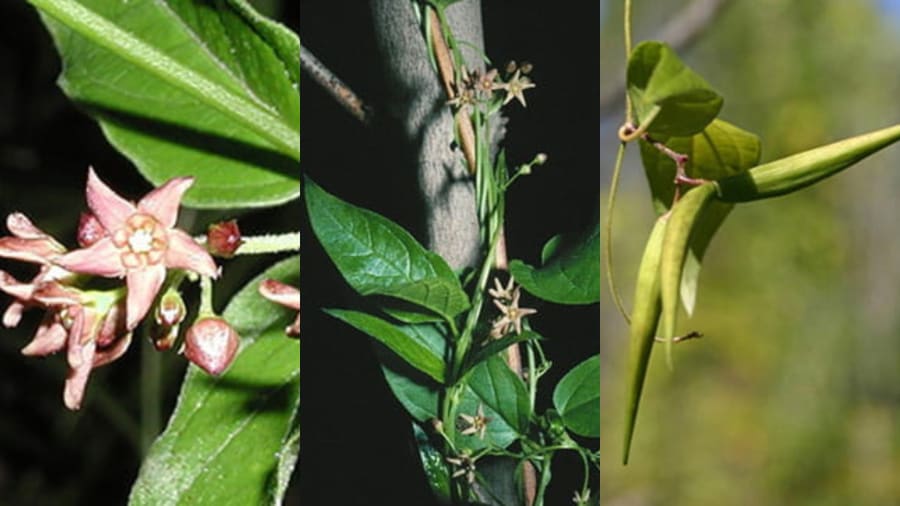
- Name: Cynanchum rossicum (Vincetoxicum rossicum)
- Status: Detected in Michigan
- Report: Use the Midwest Invasive Species Information Network (MISIN) online reporting tool.
- Learn more: Michigan.gov
This twining perennial vine grows up to seven feet in length. The leaves are shiny, medium-green to yellow, and oval to heart-shaped with a pointed tip. The small, star-shaped flowers are pale pink to reddish brown with five petals and grow in clusters of six to 10 blooms. The seed pods are milkweed-like and full of flat, brown seeds covered in fine, white hairs. Pale Swallow-wort plants have no rhizomes and grow in clumps with many stems.
This vine is tolerant of shade, sun, and a variety of soil moisture. It is usually found in disturbed areas including old fields, woodlands, and brushy areas. It can also invade perennial crops including pastures, tree farms, and no-till fields. It thrives in shallow soils and limestone bedrock of alvar areas and poses a threat to these rare ecosystems.
It is a concern in Michigan because it can form patches that crowd out native plants and disrupt ecosystems. The seeds are carried by the wind or transported by water. The roots of this vine are toxic to mammals, including livestock. The plants are toxic to many insect larvae, including monarch caterpillars.
Want to learn more? I’ve also covered Michigan’s invasive herbs, trees and shrubs, aquatic plants, and invasive diseases. More coverage is available on the Invasive Michigan page.



